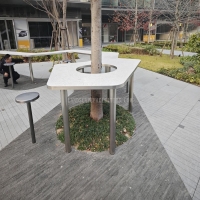Welcome to the website for landscape facilities products and knowledge.
How does the design ensure that the table remains easy to clean after outdoor gatherings?
Outdoor gatherings create wonderful memories but often leave behind cleaning challenges. Modern outdoor table design addresses this through several intelligent approaches that maintain both aesthetic appeal and practical cleanliness.
The foundation of easy maintenance begins with material selection. Designers increasingly utilize non-porous surfaces that resist liquid absorption and staining. Materials like powder-coated aluminum, tempered glass, and high-density polyethylene prevent spills from seeping into the material, allowing for simple wipe-downs. These surfaces create an effective barrier against common outdoor contaminants like food spills, bird droppings, and pollen.
Seamless construction represents another critical design element. Tables with minimal joints, crevices, or decorative carvings eliminate dirt traps where debris typically accumulates. Smooth, continuous surfaces prevent food particles and natural debris from finding hiding places, transforming what could be a detailed cleaning session into a quick surface wipe. The absence of complex patterns and intricate details means there are fewer areas requiring individual attention.
Many contemporary designs incorporate slight, imperceptible tilts in the table surface that encourage water runoff. This subtle grading prevents water pooling during rain or after cleaning, reducing mineral deposits and potential staining. Combined with integrated drainage channels in some umbrella hole designs, this feature ensures liquids don't remain stagnant on the surface.
Protective coatings and treatments extend beyond basic weather resistance. Advanced UV-resistant seals prevent color fading while creating an additional barrier against stains. Antimicrobial treatments integrated into some materials inhibit mold and bacterial growth, particularly important in humid environments. These specialized coatings maintain their effectiveness through multiple cleaning cycles without degrading the material beneath.
The integration of removable components offers practical cleaning advantages. Some designs feature interchangeable center panels or tops that can be easily removed for thorough washing. Quick-detach mechanisms allow sections to be separated without tools, enabling access to areas that typically accumulate debris.
Maintenance considerations extend to the structural elements as well. Leg designs that minimize ground contact points or feature elevated bases prevent dirt and moisture accumulation underneath. This thoughtful approach to the entire table structure, not just the surface, contributes significantly to long-term cleanliness and reduces the overall cleaning burden after outdoor events.
Through these coordinated design strategies—non-porous materials, seamless construction, water-shedding surfaces, protective treatments, and modular components—outdoor tables maintain their elegance while ensuring cleaning remains a straightforward process rather than a burdensome chore.
Related search:

Recommendation
An outdoor bar counter with stainless steel and terrazzo materials in an irregular shape